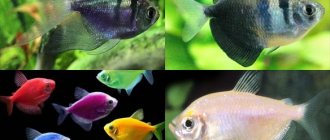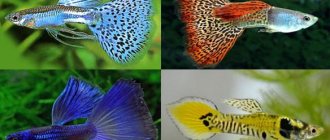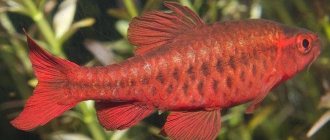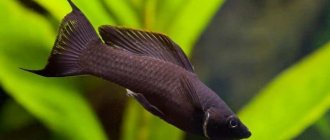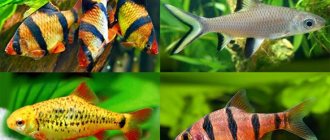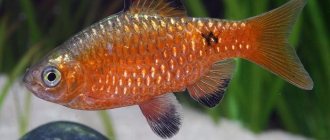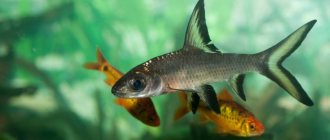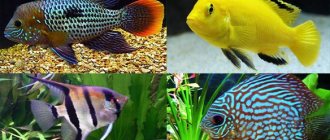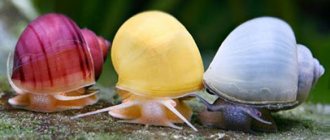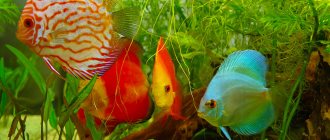Barbus
Simplicity of content:
Latin name: Puntigrus tetrazona/Barbus tetrazona
Lifespan: up to 6 years
Maximum size: 5-6 cm.
Average cost: from 45 rubles.
The Sumatran barb is one of the most common aquarium fish, beloved due to its unpretentiousness in care and maintenance. These bright and active fish, similar in appearance to small crucian carp, can enliven any artificial pond.
Habitat
The second name is Sumatran puntius. In nature, the fish lives in Indonesia and southeast Asia (native of the islands of Sumatra and Kalimantan). Now it can be found in Singapore, Colombia and the USA. In the wild, the Sumatran barb lives in clean rivers with many plants, various stones and recessed tree branches. It feeds on algae, insects and detritus.
Sex differences
How to determine the sex of a Sumatran barb? This cannot be done until the fish reaches sexual maturity. When barbs are preparing to breed, you can find males among them by their more saturated color and muzzle of a brighter red hue. Females can be identified by their rounded bellies. In addition, they are usually larger in size.
Description of the aquarium fish
Latin name: Puntigrus tetrazona.
Suitable water temperature: 21-25°C, survive at 15°C.
Acidity: 6.5-7.0 pH.
Hardness: up to 17GH.
Aggressiveness: very aggressive fish.
Content difficulty: easy.
Life expectancy: under good conditions, about 3-4 years.
Sexual maturity at 12 months, fertility up to 500 eggs.
Size: 6-7 cm.
The body of the fish has a light brown color, a high, laterally compressed body and a pointed muzzle. Four vertical black stripes run along the body. The first of them passes through the eyes, and the last near the tail. The dorsal fin is black with a red border. The remaining fins are red or pink.
It is easy to distinguish a male from a female. Females are larger and their abdomen is full. Males are smaller and brighter than females. The fins of males are bright red.
Raising fry
The process of development of a barb fry into an adult takes about 4 months. Young fish are capable of reproduction at the age of 5–6 months .
The fry must live in a separate aquarium until they reach maturity. During this period, the juveniles receive increased nutrition with live, plant food.
“Newborn” fry have a nondescript silver color. The characteristic olive color and stripes appear in fish closer to 2 months of life.
Selected species of Sumatran barb
Breeders have managed to develop new beautiful forms of barbs, which are often found in aquariums.
- Dark green barb. This includes: mossy barb or mutant, green tiger. The mossy barb has an elongated body of a dark green color, black fins with a red edge. The green tiger barb differs from the above in its golden tint and light-colored belly.
- Albinos. These include: albino, golden barb and strawberry barb. The body of the golden barb and albino is colored creamy with a hint of gold. Vertical white stripes run across the body. The fins are transparent with pink or pale red edging. The head is painted red. The body of the strawberry barb differs from the above two species in its bright pink color.
Photo: mossy and albino
- Platinum barbs. These include Platinum, Platinum and Green Platinum. Platinum barb is white with black fins. The color of the green platinum barb is white and blue, the fins are black. Sumatran barb Platinum is white with a golden tint.
- Veiled barbs are similar in body shape to Sumatrans, only they have beautiful long fins.
Photo: platinum and veil
- Glofish barbs are genetically modified fish of green or red color with black vertical stripes. In size and content they are no different from ordinary Sumatran.
Glofish
Notes
It should be noted that in nature it has a more faded color than its aquarium relative. The fish that can now be found on sale were obtained, as a rule, as a result of aquarium breeding, and the brightness of their color was enhanced by long-term selection.
A mutation in the color of the Sumatran barb can be caused, for example, by exposure of eggs to ultraviolet rays, as well as a sharp change in various water parameters in the spawning area (temperature, pH or hardness). Mutants and albinos are weaker and more finicky fish compared to their natural form.
Sumatran barb (P. anchisporus gold-greenstripe) appearance.
The genus of “Sumatran” barbs (Puntigrus) is currently represented by five species. The genus Puntigrus was created by Maurice Cottela (2013) to house a group of species previously called the "Puntius tetrazona group". Other members are P. anchisporus, P. navjotsodhii, P. pulcher and P. partipentazona, the first three of which are endemic to western, central and eastern Borneo respectively, and the last to Indochina.
Sumatran barb (Puntigrus tetrazona) was previously referred to as Puntius tetrazona, Systomus tetrazona or Capoeta tetrazona.
Maintenance and care
The fish should be kept in a flock of 6 or more fish in an aquarium with a volume of 70 liters or more. A hierarchy is established in the flock, chasing each other and showdowns begin, which do not lead to anything bad. To make the striped robbers comfortable, plant live plants in the aquarium: cabomba, spiral vallisneria, hygrophila polysperma, lemongrass. Use driftwood and stones as decoration. You can tie anubias on them, but you will have to refuse Java moss, since the fish like to pluck it, fooling around. Be sure to leave some free space for your pets to swim. Choose a dark color for the primer and background, black, on it the Sumatrans will look bright.
Note! If Sumatran barbs are kept in small numbers (1-3 fish), they become aggressive. They may start fighting with each other and with their neighbors. Do not put fry in an aquarium with barbs, as they will begin to hunt them and eventually eat them all. The same applies to shrimp.
The aquarium must have good filtration. Comfortable water temperature for fish is 21-25 degrees. To maintain it, a heater is installed in the aquarium. Once a week you should siphon the soil and replace 25-30% of the water with fresh water. Hooligans prefer to swim in the middle and lower layers of water.
Reproduction
Sumatran barbs are the true cuckoos of the fish world. They completely lack maternal instinct. Moreover, they have a tendency to eat their own eggs. Therefore, after spawning, all adult individuals are placed in another place, or a special net is placed on the bottom of the aquarium, which protects the offspring from being eaten.
Before spawning, barbs are carefully prepared for two whole weeks. They are given only live food as food, and fasting days are canceled.
To make the spawning substrate feel safe, moss or small-leaved plants are planted on the bottom.
The number of eggs per spawning from one female reaches 200 pieces, all of them are immediately fertilized by males. To prevent lesions from appearing on the caviar, it is necessary to treat it with methylene blue. It takes a little more than a day for the larvae to appear, and only after 5 days can the fry be observed swimming. At first, live dust serves as food for them, and after some time they are switched to microworms.
Compatibility with other aquarium fish
The best neighbors for Sumatrans will be other types of barbs: scarlet, cherry, fire. In this case, the aquarium is called a barbecue. If you want variety, then choose fast fish without long fins, for example, nimble danios, thornets, ancistrus, corydoras catfish (only if there are shelters), cockroaches, diamond tetras, swordtails, and platies.
Slow fish with beautiful long fins will be bad neighbors: angelfish, lalius, gourami, goldfish. Barbs will definitely pinch their fins. But there are also exceptions. There are many cases where barb fry grew up with angelfish and subsequently lived without problems.
Reviews
Barbs attract aquarists with their beauty and energy, as well as their unpretentiousness and omnivorous nature. But owners of slow-moving fish complain that barbs attack other fish. This is the main cause of dissatisfaction when keeping barbs.
What to feed Sumatran barbs
This type of fish is omnivorous and constantly hungry. They eat well frozen and live food: bloodworms, daphnia, tubifex, brine shrimp. They will not refuse high-quality chips, cereals and even catfish tablets. They prefer to take food in the water column, but if necessary they eat well both from the surface and from the bottom.
It is imperative to include plant foods in your diet. These can be chips or tablets with spirulina, as well as pieces of cucumber, zucchini, lettuce, and nettle pre-dipped in boiling water. If there is a shortage of plant food, the fish will eat young shoots of plants.
Sumatran barbs are prone to gluttony. If you don’t control the amount of food, they feed, get fat and die. Therefore, food must be given in moderation. Once a day, preferably on the day of cleaning, you don’t have to feed the fish.
Adviсe
- Do not overfeed barbs.
- Plant a sufficient number of plants.
- Choose a shallow aquarium rather than a long one.
- Do not share with slow and stately fish.
- Do not share with small fish or fry.
The Sumatran barb will enliven any aquarium with its cheerful temperament and will be an excellent decoration. If it seems to you that the aquarium has become slow and lifeless, then buy a barb. These fish will quickly create vigorous activity in the water; all you have to do is watch them.
Previous
Fish52 popular types of guppies
Next
FishRed neon - do not confuse it with blue
Sumatran breeding
Barbs are spawning fish. In an aquarium with good conditions, they can spawn on their own. But in this case, it is impossible to get offspring, since adult fish eat the eggs. If you want to breed Sumatrans, then prepare a spawning tank with a volume of 20 liters or more. 1.5-2 weeks before spawning, place the females separately from the males and feed them well with a variety of foods, especially plant foods.
Water for the spawning tank is taken from the general aquarium and 30% fresh is added. Then it is heated to 29 degrees. Plants with small leaves, such as cabomba, hornwort, elodea, moss or a separator net, are placed at the bottom. This is necessary to prevent the producers from eating the caviar. There should be no snails in the spawning tank, as they spoil the eggs.
Prepared individuals are placed in the spawning tank in the evening with minimal aeration and the lighting is turned on. Spawning begins early in the morning. The female lays up to 500 eggs, and the male fertilizes them. Spawning most often ends around noon. At the end of the process, the producers freeze and are transplanted into a common aquarium. Remove plants or netting from the spawning area and replace 1/3 of the water with boiled water. Then an antifungal drug is added. After a day, larvae will appear, which after 4 days can begin to be fed with ciliates, Artemia nauplii.
The young are fed frequently. After feeding, remove any uneaten food leftovers and add fresh water. The fry grow quickly, but unevenly. To prevent larger babies from starting to eat smaller ones, they should be sorted. Over the course of 2-3 months, the temperature in the hatchery is reduced to 24 degrees.
Diseases
Sumatran barbs are unpretentious fish that, with proper care, will delight their owners for a long time with their bright colors and playful behavior. But careless handling by owners, vitamin deficiencies or infections can cause various diseases.
White-skinned
This is one of the common pathologies that occurs in this species of fish. Among its symptoms, in addition to lethargy and decreased appetite, can be identified a change in the color of the dorsal fin and skin near the tail to white, lightening or complete disappearance of the stripes. A sick barb stays near the surface almost all the time, and the dorsal fin sticks out.
The cause of white skin is bacteria that enter the aquarium with new inhabitants (plants or fish). To cope with the scourge, you need to:
- Dilute oxacillin (40 mg per 1 l) in a prepared container.
- Keep infected individuals in the prepared solution for 5 days.
- Wash and disinfect the main aquarium.
- Rinse the fish of the drug and return them to the restarted main aquarium.
Aeromonosis
Aeromonosis or rubella is an infectious disease that barbs can become infected with from infected fish or through dirty equipment. The infection enters the body through the gills or wounds on the body, and the incubation period is 3-8 days.
Symptoms of the disease against the background of general lethargy and loss of appetite are the appearance of ulcers and red spots on the body, rotting of the anal fin. Unfortunately, with such manifestations it is no longer possible to save the fish, and apparently healthy individuals are treated as follows:
- For seven days, a solution of bicilin-5 is poured into the aquarium at night.
- Infected barbs are kept in baths with antibiotics (chloramphenicol, synthomycin) and methylene blue for 6 hours.
Aquarium fish that have recovered from rubella acquire strong immunity to the disease, but can cause infection to other inhabitants.
Dropsy
Dropsy is an accumulation of edematous fluid in a body cavity. The cause of the disease is most often a bacterial infection, parasites, poor water quality in the aquarium and its sudden changes, and lack of oxygen.
In a sick individual, the scales protrude, the gill covers come off, the abdomen and sides swell, the anus protrudes, and stripes become discolored due to swelling of the skin. Symptoms may not all appear at the same time.
It is impossible to save a sick fish in the later stages, but at the very beginning of the disease you can try to improve its condition by placing it in a chloromycetin solution (80 ml/10 l) for 30 minutes.
Fin rot
This is the most common disease in aquarium fish. Its causative agents are the bacteria Pseudomonas fluorescens, which can enter the aquarium along with food, decor, soil, or new fish that have not been quarantined.
Sick barbs change their color and fins break off, their eyes become cloudy, red spots appear throughout the body due to blockage of blood vessels, and in the final stage, ulcers appear throughout the body.
To save the inhabitants of the aquarium, it is necessary to replace 30% of the water with fresh water, clean the aquarium with all its contents (soil, decor, plants). Sick barbs should be placed in a separate tank, followed by antibiotic therapy.
Obesity
Barbs are quite voracious, so if you overfeed them, you can provoke the development of obesity, which can subsequently result in the death of the pet.
The first signs of obesity are low activity and apathy, an increase in body size compared to the norm. To correct the situation, it is enough to leave the fish without food for two or three days, and then establish a normal diet.
What does he look like?
The size does not exceed 4-6 cm, more often – 3-4 cm. The body can be called slender and lean: strongly flattened on the sides, round in shape, with neat fins and a strict tail. The albino is interesting: he is a little elongated and larger.
The coloring is spectacularly bright yellow, and sometimes even golden, with the back being darker and the belly lighter. Vertical parallel black stripes add variegation. There are four of them, the first one practically crosses out the eyes, the last one is on the tail. Even a practically colorless albino has stripes (they are light pink).
Continuing one of the dark stripes is the upper fin, black, outlined along the perimeter by a red stripe. The lower fins and tail are red-pink.
When a flock of barbs rushes across the expanses of the aquarium, your eyes are just full of color. Moreover, they like to swim sharply, quickly and purposefully.
Many aquarists are of the opinion that Sumatran beauties are aggressive and non-peace-loving. Arguments are given that:
- they bite fish's tails and fins;
- attack small and calm fish;
- They hunt their relatives at night.
Such facts occur in cases where the barb is uncomfortable: little water and a large population of the aquarium, dirty water, lack of sufficient food. In other cases, it is a completely calm fish, getting along well with its own kind in size. Suitable neighbors for her are:
- gourami;
- mollies;
- swordtails;
- catfish;
- neonchiki;
- barbs of other species, including albino.
Diseases
The Sumatran barb is so unpretentious that its owners often have the false idea that the striped fish living in the aquarium never get sick. This is wrong.
How long do barbs live? With good care and caring attitude, their life expectancy can be 5 – 7 years. But improper maintenance can lead to metabolic disorders or decreased immunity for brightly colored minke whales. In such cases, diseases such as the already mentioned obesity, gill and fin rot, white skin, rubella, and dropsy may occur.
Keeping barbs is an easy and very exciting activity. Some fish lovers prefer to set aside separate aquariums for them, the so-called barbecues. They can combine subspecies of different colors, creating a colorful and interesting picture of underwater life.
